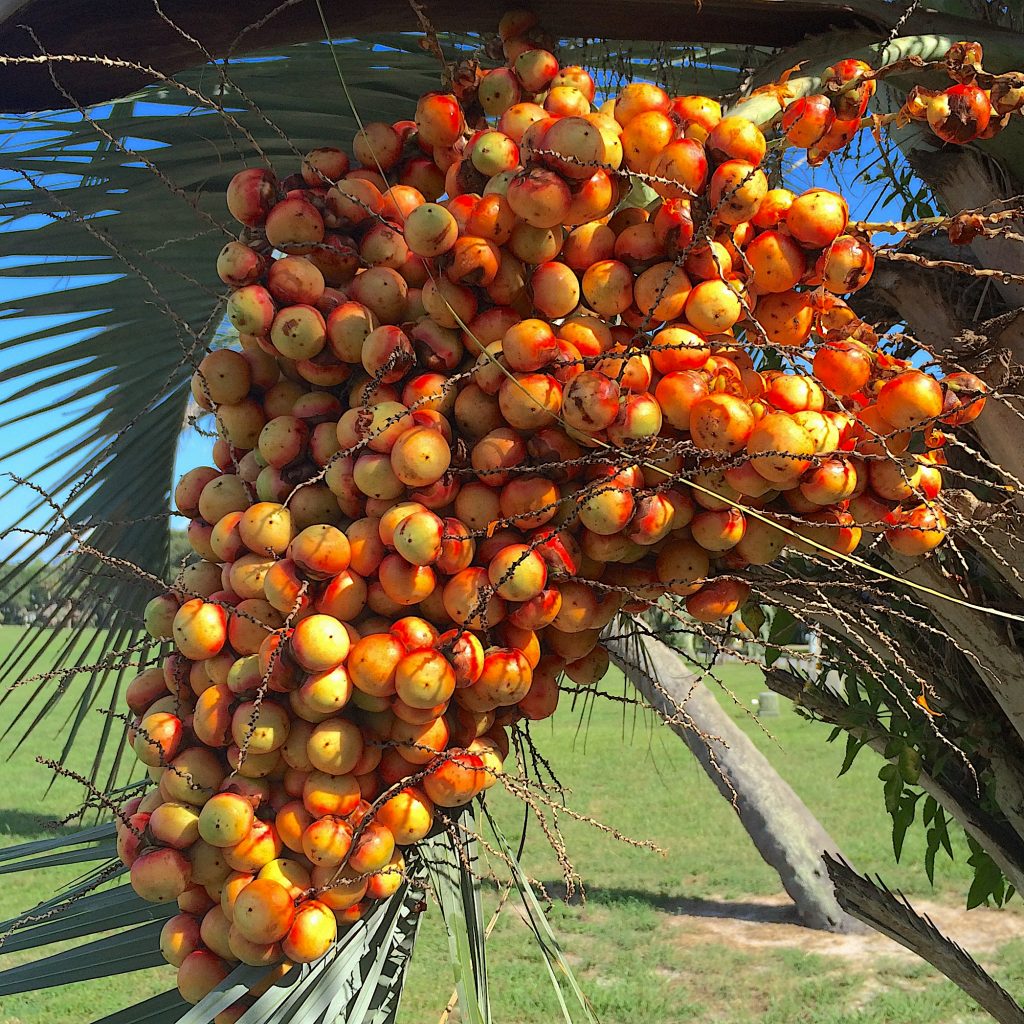
Pindo Palm can fruit almost anytime. Photo by Green Deane
Pindo Palms grow from south Texas to Washington DC and often fruit in the spring. This past week two of them dropped fruit near Tampa. Which means don’t argue with Mother Nature, just harvest, take note for next year and be thankful. Most consider yellow Pindo Palm fruit to be delicious. The seed inside is also edible and tastes like coconut. It is easy to extract (whereas the queen palm kernel is tough to get out of its shell. and the fruit is more fibrous.) Pindo palm is also called the jelly palm because some years it has enough natural pectin and sugar to make jelly without any additional pectin or sugar. While both the Pindo and queen palm have edible fruit and are feather palms they have quite different growth structures. Queen palms are usually skinny and tall, with green fruit turning orange, pindo are shortish, stout, with green fruit that turns yellow to golden. Look for both in yards and cemeteries.
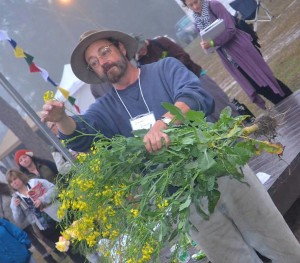
Green Deane in Deland Florida with wild mustard in February 2014.
Admittedly is uncommon to see yellow mustard and yellow Pinto palm fruit available at the same time. A common roadside plant, mustard is often a strip of yellow you see in a glance as you drive by. It is found from southern Florida to Maine but in different seasons. In the no-snow south it’s a winter plant because it is too hot in the summer for the cool-weather species. It’s a spring and summer crop “up north.” Canola oil is made from a mustard that like summer in Canada. While wild mustard and radish look similar and are used the same way, mustards tend to have most of their blossom on the top end where as radishes fall over and have blossoms along the stalk.
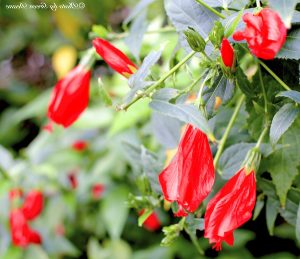
Malvaviscus pendiflorus. one of two species locally. Photo by Green Deane
We saw several species blooming this past weekend in my foraging class. The Hibiscus were happy including the “Sleepy Hibiscus.” It’s a fairly easy shrub to identify because the bright red blossoms never unfurl. The delicate blossoms dissolve quickly upon consumption. Some would call them slimy. Also blossoming is the Bauhinia. It’s a tree that is both easy and challenging at the same time. The blossoms are edible, look nice in salads. Some of the species have edible seeds and some do not. (They are in the pea family and most pea trees — most not all — do not have edible seeds.) Sorting out which Bauhinia you have can be a challenge, nearly as bad as sorting out which Cereus you have. Like the Cereus cactus there are several man-made Bauhinia hybrids and perhaps even some fake botanical names. It can make species identification a real headache though as far as I know all the blossoms are edible. Only “discovered” a century or so ago the blossom of the Bauhinia blakeana is the emblem of Hong Kong. You can read about the Bauhinia here.
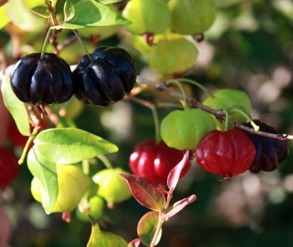
Surinam Cherries have eight ribs.
Almost every year one can find a species blooming out-of-season. If the climate changes we might see an increase in that. As in previous classes we saw some grapes blossoming in early December when they should be setting in the spring. But perhaps the most out-of-season display this week was Surinam Cherries in fruit. I had Suriname Cherries in my yard for many years. They are best when a deep red with a bit of blue hue like the color old time firetrucks. If Ferrrari orange they are not ripe. Even when ripe many people do not like the taste of them. To read about the Suriname Cherry go here.

Classes are held rain or shine (but not during hurricanes.)
Foraging Classes: A summer problem has cropped up. Severe weather.
Because of severe weather predicted for Dec.16th and 17th classes those days have been canceled
Dec 30th, Dreher Park, 1200 Southern Blvd., West Palm Beach, 33405, 9 a.m. meet just north of the science center.
To read more about the classes, to pre-pay or sign up, go here.
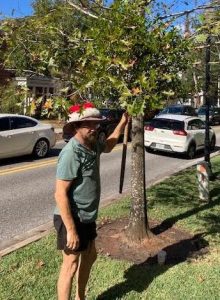
Finding Mistletoe during the 13th annual Urban Crawl in Winter Park.
My 14th annual Urban Crawl is coming up, on Friday Dec. 22nd, 2023, in downtown Winter Park. It is a free class. A reasonable question is what about foraging in a city? There is some surprising research. Dan Brabaner is a geoscience professor at Wellesley College, Boston. With some undergraduate students they studied preserved food collected from fruit trees and the like in the urban Boston area. What they found was cherries, apples, peaches and herbs were relatively low in lead and arsenic. That is, a serving had less amounts of these toxins than the allowed daily amount for a child. The team also did not find a significant difference between peeled and unpeeled fruit. The fruit was low in toxic chemical because they are the furthest away from any toxins in the soil. This would apply to tree nuts as well. Leafy greens faired well, too, because they grow fast and 1) don’t have time to accumulate toxins and 2) most air pollution on them can be washed off. Brabander also analyzed foraged food from plants growing in the urban environment not growing on agricultural soil. These foods had higher micronutrients because they were not growing on worn-out agricultural soil. Calcium and iron were higher as were manganese, zinc, magnesium and potassium. Thus we know that not only do “weeds” pack more of a nutritional punch because they are wild but also because they can be growing in better soil. We meet in front of Panera’s at 10 a.m. We wander south to the Rollin college, stop at Starbucks, to drink and drain, go east to the public library area, then back to Panera’s, that takes a couple of hours. Park in the parking garage behind (west of ) Paneras. If you park more than three hours on the streets of Winter Park you can get a ticket (this has happened in previous years.) Please invite anyone interested in plants who is having a hard time making ends meet.
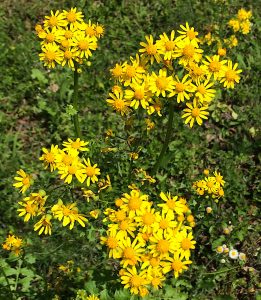
Toxic Butterweed’s blossom does not resemble a mustard. Photo by Green Deane
A dangerous plant is making its seasonal debut: Butterweed, Packera glabella (formerly Senecio glabellus.) I call it dangerous because it is toxic and resembles an edible species. Butterweed likes to grow in damp places and until it blossomed resembles the mustard family. However, unlike all mustard which have four petal blossoms, Butterweed’s blossom resembles a yellow daisey. And mustards have a distinct flavor, Butterweed has a mild taste. Overs the season it becomes attractive and prolific. There has been at least one poisoning in Florida in recent years. The victim survived with medical attention. The toxin affects the liver. it is also highly toxic to horses and cattle.

You get the USB, not the key.
172-video USB would be a good holiday present and is now $99. My nine-DVD set of 135 videos has been phased out. The USB videos are the same videos I have on You Tube. Some people like to have their own copy. The USB videos have to be copied to your computer to play. If you want to order the USB go to the DVD/USB order button on the top right of this page. That will take you to an order form. I’d like to thank all of you who ordered the DVD set over the years which required me to burn over 5,000 DVDs individually.

Green Deane Forum
Want to identify a plant? Perhaps you’re looking for a foraging reference? You might have a UFO, an Unidentified Flowering Object, you want identified. On the Green Deane Forum we — including Green Deane and others from around the world — chat about foraging all year. And it’s not just about
warm-weather plants or just North American flora. Many nations share common weeds so there’s a lot to talk. There’s also more than weeds. The reference section has information for foraging around the world. There are also
articles on food preservation, and forgotten skills from making bows to fermenting food.
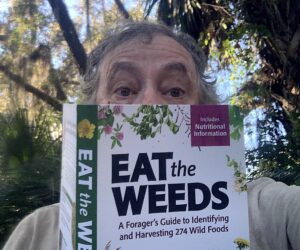
Finally, a physical copy of the book.
Now in print and delivered last week is EatTheWeeds, the book. It has 274 plants, 367 pages, index, nutrition charts and color photos. Several hundred have been pre-ordered on Amazon. Most of the entries include a nutritional profile and if no profile reported then noteworthy constituents. I have no doubt that the book will outlive me, my little contribution to posterity.
This is weekly newsletter #582. If you want to subscribe to this free newsletter you can find the sign-up form in the menu at the top of the page.

